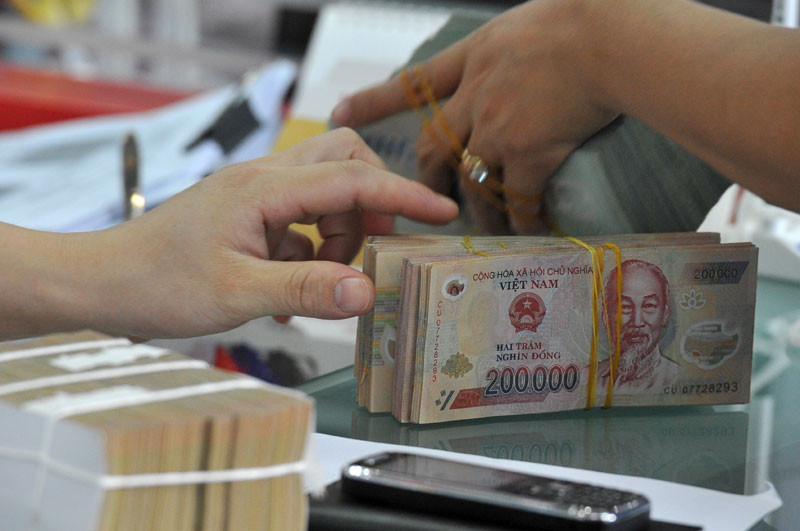
The minimum 6-month interest rate applied to deposits at the counter is 5.5 percent per annum and the maximum is 8.05 percent, which means a gap of 2.55 percentage points. For online deposits, the minimum interest rate is 6 percent and a maximum 8.3 percent, which means the gap of 2.3 percentage points.
Meanwhile, the interest rates for 9-month deposits at the counter are 5.5 percent at minimum and 8.15 percent at maximum (the gap of 2.65 percentage points), and the figures are 6 percent and 8.4 percent, respectively for online deposits (2.4 percentage points).
The gaps are smaller for 12-month term deposits – 6.6 vs 8.25 percent (1.65 percentage point) for deposits at the counter, and 6.7 vs 8.5 percent (1.8 percentage point) for online deposits.
GPBank, NCB, SeaBank, VietA Bank, ABBank and PVComBank are offering the highest deposit interest rates, while the ‘big four’, BIDV, ViettinBank, VietcomBank and AgriBank, are offering the lowest.
Pham Nam Kim, a respected economist, noted that the interest rate tables can see the big difference between the banks. Small banks with less fame, small transaction network, high operation costs, and difficulties in debt collection still have liquidity problems and need to offer high interest rates to attract more capital.
It is now even difficult to seek capital in the interbank market, so mobilizing capital from the public at high interest rates proves to be the most feasible solution.
Many Vietnamese deposit money at small commercial banks to enjoy high interest rates. Depositors don’t fear risks when depositing money at small banks as they believe that the central bank and the government will not let any bank go bankrupt and will rescue weak banks if necessary.
But when some commercial banks cut the 6-month and longer-term deposit interest rates to 7 percent per annum, people did not want to deposit money at these banks anymore.
They will withdraw deposits at the banks when the deposits mature in order to deposit at other banks which offer higher interest rates. That is why the average interest rate won’t fall sharply.
When liquidity is weak, small banks have to raise interest rates to attract money, and other banks, in order to compete with small banks in capital mobilization, also have to raise interest rates, thus creating an interest rate race.
In an effort to stop this, the central bank once had to impose a ceiling deposit interest rate policy, i.e. set a cap on deposit interest rates. However, the policy could not bring the desired effect because small banks in a scramble for clients secretly negotiated with depositors on paying additional interest rates.
Banks, businesses entangled
In principle, when deposit interest rates are high, lending interest rates can’t be low. Lending interest rates are calculated by the average input capital cost plus a margin of 3.5-4 percent.
With a high deposit interest rate of 8 percent per annum offered by small banks, the lending interest rate would be 11.3 percent at minimum, twice as much as other regional countries.
In late April 2023, Deputy Governor of the State Bank of Vietnam (SBV) Dao Minh Tu named the commercial banks which were providing loans at high interest rates, stressing that this was affecting the banking system’s effort to cut interest rates. Businesses now say they can bear interest rates of 6-7 percent only.
In reply, a bank said it had to mobilize capital at high interest rates, so it had to set high lending interest rates to ensure operation and risk management.
The power of monetary policy
SBV Governor Nguyen Thi Hong, when explaining the monetary policy pursued by SBV in 2022 before the National Assembly late last week, said there were two important reasons in 2022 why high interest rates were accepted.
First, the interest rates in the international market had increased rapidly and sharply. Policymakers needed to be cautious about the risk of inflation. Second, there was pressure on the Vietnam dong devaluation in 2022 after countries tightened monetary policy and the dollar appreciated sharply.
If Vietnam had not applied flexible and comprehensive measures, the dong would not have been stable and depreciation would not have been so low, just 3.5 percent in 2022.
“What would have happened if the Vietnam dong had lost its value by more than 10 percent? Enterprises would have been in big difficulties because domestic production depended on input material imports. The currency depreciation, plus the high input material prices, would have pushed the inflation rate up, while the debt payment duties would have increased,” she said.
Tran Thuy